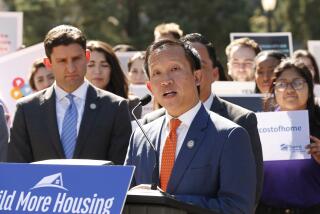County Asks State for its ‘Fair Share’ of Taxes : Government: Post-Proposition 13 property tax rules shortchange San Diego County by nearly $100 million a year, the suit contends.
- Share via
San Diego County’s years-long lament that it does not receive its fair share of property tax revenue from Sacramento moved into a courtroom Tuesday, as county lawyers urged a Superior Court judge to strike down funding formulas that they claim shortchange San Diego by nearly $100 million annually.
In opening arguments in a case with possible statewide ramifications, Deputy County Counsel Michael Poynor told Judge Michael I. Greer that San Diego County has been “perpetually punished” by tax allocation rules stemming from Proposition 13, the landmark 1978 property tax-cutting initiative.
The state Legislature, in implementing Proposition 13, developed property tax distribution formulas based on local governments’ prior levels of taxation. Because San Diego County had lower taxes--and, consequently, lower service levels--than many other counties in the late 1970s, the formulas left it with a smaller percentage of property tax funds than higher-taxing areas in the intervening dozen years.
During the 1989-90 fiscal year, for example, county officials estimate that San Diego received about $94 million less than it would have gained if it received the statewide average in property tax revenue. Since Proposition 13’s passage, San Diego County has received nearly $1 billion less than its “fair share,” county administrators contend.
Although not disputing that San Diego County has received less tax revenue than other counties, state attorneys argue that the funding gap results from “rational” legislative decisions beyond judicial purview. In short, the state contends that any tax allocation formula is likely to have inequities resulting in winners and losers, and that San Diego County simply finds itself in the unfortunate position of being in the latter category.
“When you talk about distributing money to 58 counties, you start out with many unequals,” California Deputy Atty. Gen. David Chaney said. “So you’re going to have inequities when you do that. The constitutional question is who gets to make those decisions: a judge or the Legislature. We say it’s the Legislature.”
Martin Helmke, chief tax consultant to the Senate Committee on Revenue and Taxation, testified Tuesday that the Legislature, in setting up the existing formulas, sought to “distribute property tax revenue in a way that did not ignore history.” State legislators, he explained, did not want to create a system that would force local governments to deliver less service to constituents than they had before Proposition 13.
County attorney Poynor, however, argued that, by basing the funding formulas on counties’ past spending practices, the Legislature in essence forced formerly low-taxing counties such as San Diego to “subsidize” past high-taxing governments. The resulting county-to-county revenue disparities, he said, are unconstitutional, violating the guarantees of equal protection and due process.
Before Proposition 13, Poynor noted, counties had discretion over their level of local taxes and services. While San Diego County chose low taxes and services, other large counties opted to tax their residents at higher rates and to deliver more services.
The 1978 initiative, however, established a 1% property tax rate statewide, resulting in what Poynor characterized as a “discriminatory system that . . . literally rewards the high-tax government entities and punishes the low-tax government entities.”
“Now, residents of formerly low-taxing areas pay the same 1% tax rate as everyone else, but get less property tax revenues for government services,” Poynor said.
The funding formulas not only produce unequal county-by-county allotments but also create inequities in how the tax money that is received must be spent, Poynor told Greer.
Statewide, non-school local governments receive an average of 64 cents out of every dollar collected, with the other 36 cents going to schools. In San Diego, however, 50% of the revenue goes to schools, and the other 50% is divided among the county government, 18 cities and special districts.
Though the county’s major aim in the lawsuit is to overturn the existing tax formulas to prevent what it views as potential future inequities, it also hopes to be compensated, at least in part, for past shortfalls, according to county spokesman Bob Lerner.
“We’re not in this for a hollow legal victory,” Lerner said. “We want the bucks.”
More to Read
Sign up for Essential California
The most important California stories and recommendations in your inbox every morning.
You may occasionally receive promotional content from the Los Angeles Times.













